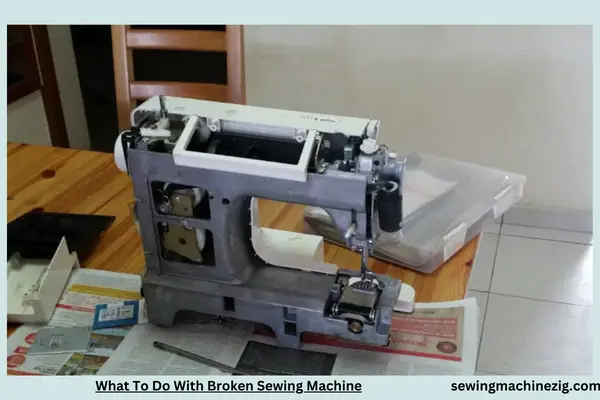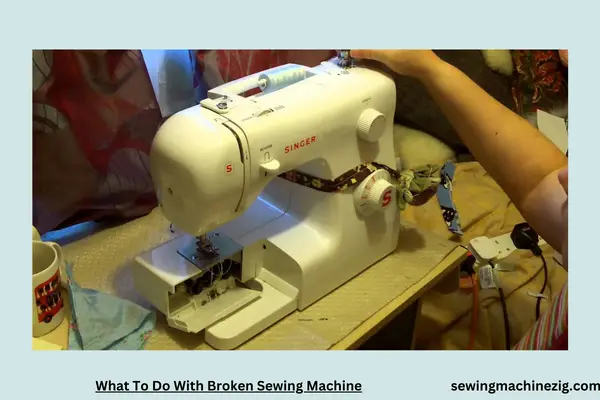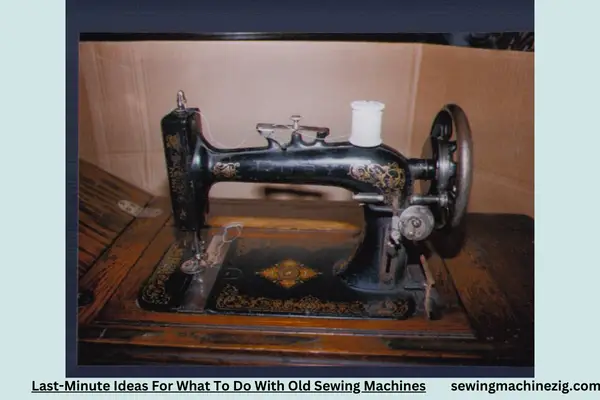
If you’ve found yourself with a broken sewing machine, don’t despair; there are numerous creative ways to repurpose and transform it into something new and useful. In this guide, “What To Do With Broken Sewing Machine”we present 35 innovative ideas for what to do with a broken sewing machine.
Thank you for reading this post, don't forget to subscribe!From crafting unique furniture pieces to turning them into a captivating art installation, these suggestions will inspire you to see your malfunctioning machine not as a setback but as an opportunity for inventive and sustainable projects. Embrace the challenge and discover the endless possibilities hidden within your broken sewing machine.
What To Do With Broken Sewing Machine Detailed Answer

(35 Ideas for) What to Do With a Broken Sewing Machine: A Creative Guide to Repurposing
When your trusted sewing machine reaches the end of its functional life, don’t toss it aside – embrace the opportunity for creative transformation. In this comprehensive guide, “What To Do With Broken Sewing Machine” @e present 35 innovative ideas for what to do with a broken sewing machine, turning what might seem like a setback into a wealth of imaginative possibilities.
Step 1: Salvage Usable Parts Before diving into repurposing, salvage any salvageable parts. Elements like the motor, foot pedal, or needle plate might find new life in other DIY projects.
Step 2: Convert into a Table Transform the sewing machine into a stylish and functional table. Remove the machine components, add a tabletop, and voila – a unique furniture piece.
Step 3: Craft a Wall Shelf Use the machine’s frame to craft a wall shelf. Mount it horizontally, creating a vintage-inspired display space for your favorite trinkets.
Step 4: Create Wall Art Detach the decorative elements of the sewing machine, such as the tension assembly or presser foot, and arrange them in a shadow box for striking wall art.
Step 5: Outdoor Garden Planters Repurpose the machine’s base into outdoor planters. Fill them with soil and vibrant flowers, adding a touch of whimsy to your garden.
Step 6: Antique Drawer Pulls Remove the machine’s drawers and repurpose them as unique antique drawer pulls for furniture or cabinets.
Step 7: Sewing Machine Drawers as Storage Utilize the drawers to create standalone storage units. Add legs, repaint, and you have stylish storage for various items.
Step 8: Table Lamp Base Turn the machine’s body into a vintage-inspired table lamp base. Combine it with a complementary lampshade for a functional and aesthetically pleasing lighting fixture.
Step 9: Decorative Mirror Frame Incorporate the machine’s intricate details into a decorative mirror frame, adding a touch of vintage charm to your living space.
Step 10: Sewing Machine Base Bench Repurpose the base into a charming bench by adding a cushioned seat. This makes for a unique and practical addition to any room.
Step 11: Photo Frame Collage Convert the machine’s decorative elements into photo frames. Arrange them in a collage, preserving the machine’s history in a creative way.
Step 12: Wall Clock Fashion a unique wall clock by incorporating the machine’s circular elements. This functional and artistic piece becomes a conversation starter.
Step 13: Sewing Machine Drawer Shelves Mount the drawers horizontally on a wall to create rustic shelves, perfect for displaying small decor items.
Step 14: Jewelry Organizer Convert the machine’s drawers into a stylish jewelry organizer. Add dividers for earrings, necklaces, and other accessories.
Step 15: Quirky Bookends Use the machine’s sturdy parts, such as the base or metal frame, to craft quirky bookends that reflect your love for sewing.
Step 16: Vintage Sign Repurpose the machine’s body into a vintage-inspired sign. Paint a favorite quote or use it to display your family name.
Step 17: Outdoor Bench Combine multiple sewing machine bases to create a unique outdoor bench. Add a wooden seat for a comfortable and eye-catching addition to your garden.
Step 18: Coffee Table Craft a one-of-a-kind coffee table by repurposing the machine’s components. Top it with glass for a polished finish.
Step 19: Sewing Machine Leg Console Table Detach the legs and create a stylish console table. Add a wooden or glass top to complete the look.
Step 20: Wall Hooks Transform smaller components into wall hooks. These functional and decorative hooks can hold keys, bags, or even kitchen utensils.
Step 21: Sewing Machine Base Sink Stand Turn the base into a distinctive sink stand for a vintage-inspired bathroom or outdoor kitchen.
Step 22: Key Holder Use the machine’s components to craft a unique key holder, ensuring you never misplace your keys again.
Step 23: Display Cabinet Repurpose the machine’s body into a display cabinet for showcasing collectibles, china, or other cherished items.
Step 24: Sewing Machine Pedal Table Create a small side table using the sewing machine pedal as the base. Top it with a round piece of wood for a charming touch.
Step 25: Magnetic Board Attach the machine’s metal components to a wooden board to create a magnetic board for notes, photos, and reminders.
Step 26: Thread Spool Rack Use the machine’s horizontal components to craft a vintage-inspired thread spool rack. Organize your threads in style.
Step 27: Sewing Machine Art Easel Transform the machine’s metal frame into a unique art easel, combining functionality with artistic flair.
Step 28: Vertical Garden Stand Create a vertical garden by attaching small potted plants to the machine’s frame. This inventive garden stand brings greenery indoors.
Step 29: Sewing Machine Drawer Shadow Boxes Convert the drawers into shadow boxes, displaying small treasures or creating themed decor displays.
Step 30: Sewing Machine Wall Sconces Repurpose the machine’s arms into wall sconces. Add LED candles for a vintage-inspired lighting solution.
Step 31: Thread Holder Organizer Attach wooden dowels to the machine’s frame for a practical thread holder organizer. Keep your threads easily accessible and neatly arranged.
Step 32: Plant Stand Create a plant stand by attaching a wooden board to the machine’s base. Elevate your potted plants with a touch of vintage elegance.
Step 33: Magazine Rack Fashion a magazine rack using the machine’s sturdy components. Organize your reading materials in a stylish and functional manner.
Step 34: Vintage Sewing Machine Wine Rack Transform the machine’s drawers into a unique wine rack. Showcase your wine collection in a conversation-starting display.
Step 35: Sewing Machine Headboard Attach the machine’s decorative elements to a wooden headboard for a vintage-inspired bed frame. Add charm to your bedroom with this distinctive piece.
A broken sewing machine is not the end of its story; it’s the beginning of a myriad of creative possibilities. These 35 ideas showcase the versatility of repurposing and offer a sustainable and imaginative approach to giving new life to your beloved sewing companion. “What To Do With Broken Sewing Machine”
Explore these projects and let your creativity flow as you transform a broken sewing machine into functional and aesthetically pleasing pieces for your home. ““What To Do With Broken Sewing Machine”“
Last-Minute Ideas For What To Do With Old Sewing Machines

If you find yourself with an old sewing machine that’s no longer serving its primary purpose, don’t rush to discard it. There are numerous creative and practical ways to repurpose or breathe new life into your old sewing companion.
In this comprehensive guide, we’ll explore step-by-step ideas on what to do with old sewing machines, providing you with last-minute inspiration and options to consider.
Step 1: Assess the Condition of the Sewing Machine
Before diving into repurposing, assess the current condition of your old sewing machine. Check for any salvageable parts, rust, or damage that may affect its functionality. This evaluation will help you determine the best course of action for repurposing.
Step 2: Restore and Refurbish for Functional Use
If your old sewing machine is still in decent condition but requires some TLC, consider restoring and refurbishing it for functional use. Clean the machine thoroughly, oil its parts, and replace any worn-out components. With a bit of effort, you might revive it for use in your crafting endeavors.
Step 3: Transform into a Unique Table or Desk
Turn your old sewing machine into a stylish and functional piece of furniture. Remove the sewing components and repurpose the base into a table or desk. You can add a glass or wooden top to create a unique and vintage-inspired piece for your home or workspace.
Step 4: Convert into a Standalone Crafting Station
For crafters and DIY enthusiasts, transform your old sewing machine into a standalone crafting station. Add storage drawers or shelves for organizing supplies, and use the machine’s table as a spacious work surface. This repurposing idea not only breathes new life into the sewing machine but also enhances your crafting space.
Step 5: Create a Quirky Garden Planter
Give your garden a touch of whimsy by repurposing your old sewing machine into a garden planter. Remove the sewing components, fill the drawers with soil, and plant your favorite flowers or herbs. This unique garden feature adds character to your outdoor space.
Step 6: Design a Vintage-Inspired Bar Cart
Embrace the retro charm of your old sewing machine by transforming it into a vintage-inspired bar cart. Remove the sewing components, install shelves or trays, and add wheels for mobility. Stock it with your favorite beverages, glassware, and bar accessories for a conversation-starting addition to your home.
Step 7: Upcycle into Wall Art or Decor
Get creative and turn parts of your old sewing machine into unique wall art or decor. Frame the machine’s decorative elements or repurpose its metal components into sculptures. This step allows you to showcase the machine’s vintage aesthetics in a new and artistic way.
Step 8: Donate or Gift to a Crafty Friend
If you find yourself unable to repurpose the sewing machine personally, consider donating or gifting it to a crafty friend or family member. Someone with a passion for vintage items or a knack for restoration might appreciate the opportunity to give the sewing machine a new lease on life.
By following these step-by-step ideas,“What To Do With Broken Sewing Machine” you can turn your old sewing machine into a functional and aesthetically pleasing addition to your home or creative space. Whether you choose to restore it for practical use or repurpose it into a unique piece of furniture, the possibilities are endless for breathing new life into your old sewing companion.
Conclusion
In conclusion, “What To Do With Broken Sewing Machine” dealing with a broken sewing machine can be daunting, but with the right approach, it can become an opportunity for learning and improvement. Whether opting for professional repairs, seeking DIY solutions, or considering an upgrade, understanding the options is crucial.
By carefully assessing the extent of the damage and weighing the costs against the benefits, individuals can make informed decisions on what to do with their broken sewing machines. Remember, a broken machine doesn’t necessarily mean the end of your sewing journey—it might just be a stitch in time for a valuable upgrade.
FAQS
Q1: My sewing machine is broken. What should I do to fix it?
A1: If your sewing machine is malfunctioning, consider troubleshooting common issues first. Check the manual for guidance or seek online resources. Simple problems may have DIY solutions, saving you time and money.
Q2: Can I repair my broken sewing machine myself?
A2: Yes, depending on the issue. Minor problems like thread jams or needle misalignment can often be resolved at home. Consult your machine’s manual for troubleshooting steps or explore reputable online tutorials.
Q3: When should I seek professional help for my broken sewing machine?
A3: If DIY attempts don’t resolve the issue, or if the problem is complex, it’s advisable to consult a professional sewing machine technician. They have the expertise to diagnose and fix more challenging problems.
Q4: Is it worth repairing an old sewing machine, or should I consider buying a new one?
A4: Assess the overall condition and age of your sewing machine. If it’s an older model with frequent issues, investing in a new machine might be more cost-effective in the long run. Compare repair costs with the price of a new, reliable machine. “What To Do With Broken Sewing Machine”
Q5: Can a broken sewing machine be recycled or disposed of responsibly?
A5: Absolutely. Check with local recycling centers or electronic waste disposal facilities. Some organizations also accept old sewing machines for refurbishing or recycling, promoting eco-friendly disposal practices. “What To Do With Broken Sewing Machine”
Q6: Are there any creative ways to repurpose a broken sewing machine?
A6: Indeed. Turn your broken sewing machine into a unique piece of decor or salvage its parts for DIY projects. From crafting tables to artistic installations, repurposing offers a creative alternative to disposal. “What To Do With Broken Sewing Machine”



